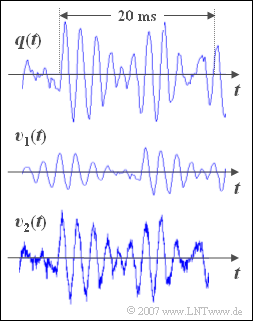Exercise 1.1: Music Signals
From LNTwww
On the right you see a $\text{30 ms}$ long section of a music signal \(q(t)\). It is the piece »For Elise« by Ludwig van Beethoven.
- Underneath are drawn two sink signals \(v_1(t)\) and \(v_2(t)\), which were recorded after the transmission of the music signal \(q(t)\) over two different channels.
- The following operating elements allow you to listen to the first fourteen seconds of each of the three audio signals \(q(t)\), \(v_1(t)\) and \(v_2(t)\).
Original signal \(q(t)\):
Sink signal \(v_1(t)\):
Sink signal \(v_2(t)\):
Notes: The exercise belongs to the chapter »Principles of Communication«.
Questions
Solution
(1) Correct is solution 2:
- In the marked range of $20$ milliseconds approx. $10$ oscillations can be detected.
- From this the result follows approximately for the signal frequency: $f = {10}/(20 \,\text{ms}) = 500 \,\text{Hz}$.
(2) Correct is solution 1:
- The signal \(v_1(t)\) is undistorted compared to the original signal \(q(t)\). The following applies: $v_1(t)=\alpha \cdot q(t-\tau)$.
- An attenuation \(\alpha\) and a delay time \(\tau\) do not cause distortion, but the signal is then only quieter and delayed in time, compared to the original.
(3) Correct are the solutions 1 and 3:
- One can recognize additive noise both in the displayed signal \(v_2(t)\) and in the audio signal ⇒ solution 3.
- The signal-to-noise ratio is approx. $\text{30 dB}$ $($but this cannot be seen from the mentioned data$)$.
- Correct is also solution 1: Without this noise component \(v_2(t)\) would be identical with \(q(t)\).
(4) The signal \(v_1(t)\) is identical in form to the original signal \(q(t)\) and differs from it only
- by the attenuation factor $\alpha = \underline{\text{0.3}}$ $($this corresponds to about $\text{–10 dB)}$,
- and the delay time $\tau = \underline{10\,\text{ms}}$.
